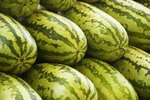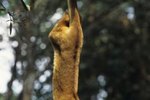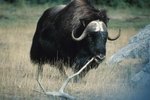
The term "black-tailed deer" describes two separate and distinct mule deer subspecies. These two subspecies are the Sitka deer (Odocoileus hemionus sitkensis) and the Columbian black-tailed deer (Odocoileus hemionus columbianus), both of which inhabit Canada and the United States. The two subspecies both consume herbivorous diets, but their feeding habits nonetheless are not exactly the same.
Sitka Diet
Sitka black-tailed deer feed on lots of foliage from shrubs. Herbs are also big components of their meals. Both shrubs and herbs are especially big food staples for Sitka black-tailed deer in the summer months. In colder times of the year, they focus more on browse and also on forbs from evergreen trees -- think bunchberry. They gain access to these forbs mostly in times without snow. Lichens are also important components to their diets, specifically those from trees. Grass is not a typical food item for them.
Sitka Habitat and Feeding
Sitka black-tailed deer generally inhabit rainforests of coastal locales. To survive in the winter, they have to be in primary forests that are less than 1,000 feet high up. Higher elevations simply have too much snow for them to be able to easily find food. Hemlock and spruce forests are both common wintertime environments for Sitka black-tailed deer. Their winter habitats are beneficial for allowing sufficient light to pass through -- and therefore allowing the proper development of plants for valuable food.
Columbian Diet
Forbs and shrubs are both major parts of the Columbian black-tailed deer diet. Browse courtesy of woody trees and shrubs is big for them. They sometimes feed on several different types of grass, including orchardgrass, brome grass and bluegrass. Columbia black-tailed deer regularly dine on things such as mushrooms and lichens. They occasionally munch on berries. They'll eat cultivated crops like peas when they get the chance.
Columbian Habitat and Feeding
Habitats for Columbian black-tailed deer are diverse and numerous; like their diet, they differ slightly from those of Sitka black-tailed deer. They frequently reside on the outskirts of forests, particularly those that provide easy paths to spacious grassland. Columbian black-tailed deer spend a lot of time eating grass in mountain grasslands and on the edges of woodlands, particularly at daybreak and nightfall. When they eat at night, they tend to gravitate toward wide and airy settings. They frequently feed in environments that feature plenty of brush, too.
References
- Mount Diablo Interpretive Association: Common Mammals of Mount Diablo State Park
- Alaska Zoo: Sitka Black-tailed Deer
- Olympic National Park: Blacktail Deer
- Alaska Department of Fish and Game: Sitka Black-tailed Deer
- USDA: Habitat Management for Black-Tailed Deer
- National Geographic: Columbian Black-Tailed Deer
- IUCN Red List of Threatened Species: Odocoileus hemionus
Photo Credits
-
Ryan McVay/Digital Vision/Getty Images




